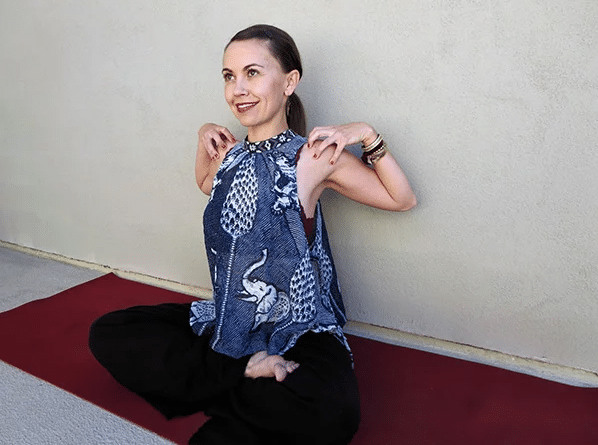
When people stick their butt in the air during a push-up, it’s typically in an attempt to make the exercise easier. That’s not good for your shoulders, and means you’re not properly engaging all of your core muscles. But in a pike push-up, you have permission to do exactly that… which is actually turning things up a notch. Pike push-ups are incredibly challenging, and they require a lot of upper-body strength to pull off correctly.
Remember, a pike push-up is just one of many push-up options, from easy to hard variations. Make sure to choose the one that suits your fitness level and the specific muscles you’re trying to work.
What is the difference between a push-up and a pike push-up?
The fact that you stick your butt in the air during a pike push-up is just the beginning of the difference, because that change of form causes a lot of other differences between the two strengthening exercises.
“All variations of push-ups are extremely effective body weight movements that work multiple muscle groups in the body,” says Laura Lee Crabbe, certified personal trainer and nutritionist at Caliber. “The difference between a pike push up and a regular push up is the orientation of your body. For regular push ups, you’ll maintain a flat back that is parallel to the ground, much like the standard plank position. For pike push ups, your hips will be upright, forming an upside down v position with your body. Your head will lightly touch the floor as you bring your arms down. In this position there is more of an emphasis on working your arms and shoulders, whereas regular push ups work more of the chest & core. Pike push ups are also great to incorporate into your training if you are working your way up to performing headstands.“
Here’s how to do a standard push-up:
Instead of starting in plank, a pike push-up starts in a downward dog position. Then once you’re stable, you bend your elbows and complete an angled push-up, all while keeping your body in an inverted V-shape for the ultimate challenge. Once your head is hovering right above the floor, you finish the push-up by using all your strength to straighten your arms and return back to the downward dog position. It’s anything but easy.
Are pike push-ups harder than normal push-ups?
Pike push-ups are a more advanced variation of a push-up, and they work different muscles.
“It’s not really a matter of which push up variation is better than the other, but rather which muscles you want to focus on,” Crabbe says.
But generally, pike push-ups are considered more difficult than standard push-ups.
“Push ups alone are a difficult move, and I do think regular push up form should be mastered before moving into other variations, including the pike push ups,” Crabbe says. “You’ll want to ensure that you have a strong core, and do not have any injuries with your shoulders before attempting pike-push ups. If you regularly perform push ups and your body has adapted to that difficulty level (meaning you have to continue to increase the repetitions to make them more challenging), pike push ups are a great exercise to switch things up.”
What muscles do pike push-ups target?
Regular push-ups work your shoulders, chest, triceps, core—which includes the glutes and the posterior chain. Rather than distributing that load across the plank of your body, pike push-ups shift shift a lot of that load forward into your arms and shoulders.
“Pike push-ups engage your deltoids, chest, triceps, biceps, upper trapezius, and core,” Crabbe says. “They are a compound movement, meaning they work multiple muscle groups at the same time. If you are wanting a move that works your entire upper body that you can do from anywhere, pike push ups are it!”
How to do a pike push-up the right way
- Start in a downward dog position with straight arms and legs.
- With your head in line with your arms and heels slightly raised off the ground, slowly bend your elbows as you lower your upper body into a push-up. Make sure to keep your legs as straight as you can.
- Once your head is slightly hovering above the ground, straighten your arms and push yourself back up to a downward dog position.
- Complete 12 reps.
How to work up to a pike push-up for beginners
A pike push-up essentially combines two moves, the downward dog and the push-up. You need to master both of these components before attempting to put it all together for a one-two punch. Getting there might involve trying a series of variations before you can execute the whole move.
“You can work on a series of push-up progressions in order to get to the pike push-up,” Crabbe says. “If you are a beginner, start with push-ups from knees, then progress to regular push-ups. Once those become comfortable, try a modified pike push-up, where your knees are slightly bent as you raise your hips up, rather than completely straight. Next, try a pike push-up, but place yoga blocks underneath your hands to provide extra support. You can also try a decline pike push-up, where you place your feet on a chair or elevated surface. Practice these progressions over the course of several weeks and you’ll be on our way to completing your first pike push up!”
How to execute a pike push-up with good form
Since this is an advanced variation, it might be tempting to rush the move or use imperfect form to compensate for a challenge. Here are form tips and pitfalls to avoid when doing pike push-ups.
Move slowly and with control
“Performing pike push ups too quickly could lead to you using your body’s momentum to complete the reps, which in turn leads to not reaching the full range of motion for this move,” Crabbe says.
Keep your elbows close to your body
“Make sure your elbows do not flare out to the side as you bring your head and arms forward,” Crabbe says. “Keeping your elbows tucked close to your body will ensure that the emphasis of this move is placed on your shoulders.”
Engage your core
Just like in a regular push-up, you want your body to maintain a consistent position without any pressure going into back. That involves getting the core involved. Engaging your core “will help keep your hips in the air and avoid any rounding of the back or pelvis,” Crabbe says.
Foot and hand width matter
You want your feet and hands to form a strong foundation for your body as it moves up in down in the pike push-up. This involves keeping your feet wider than shoulder width apart, and your hands shoulder width apart and beneath your shoulders. This position is all about stability, and making sure you’re engaging the right muscles. “Keeping the feet too close together can lead to less balance and stability, and placing your hands too far away from your body takes the emphasis away from your deltoids,” Crabbe says







